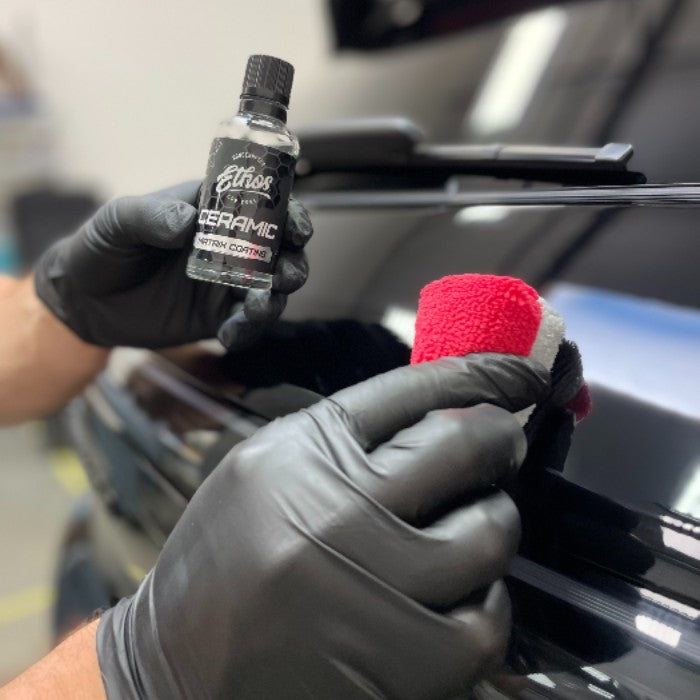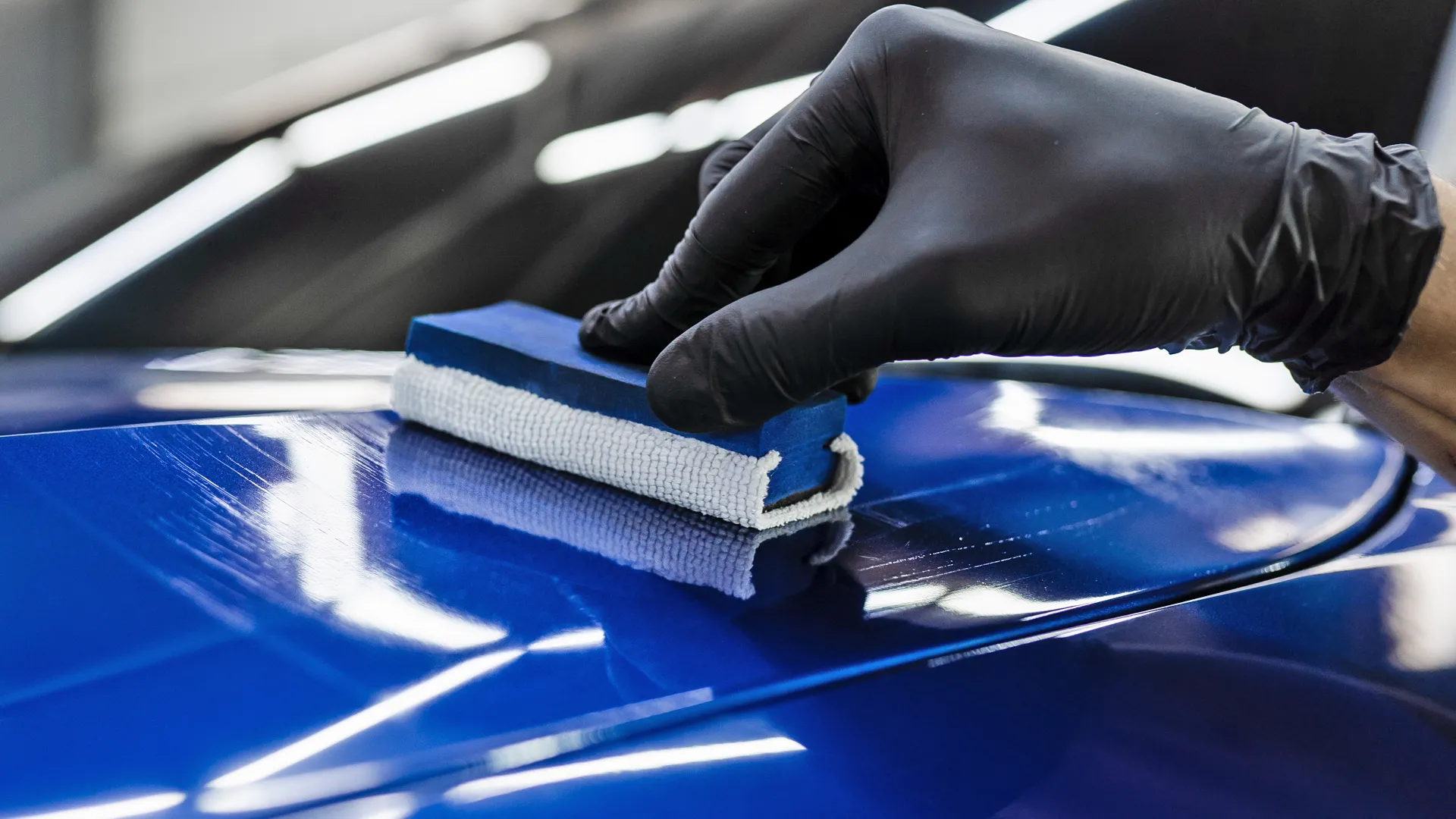Ten maintenance tips to make Ceramic Coating Newark last longer
Wiki Article
Exploring the Scientific Research Behind Car Ceramic Coating and Its Protective Features
The science of car ceramic coating offers an interesting research in advanced automobile security. Made up largely of silicon dioxide and polymers, these finishings develop a robust bond with lorry paint. This communication enhances sturdiness against ecological threats while providing hydrophobic benefits. Nevertheless, the ins and outs of just how these layers job and their long-term benefits continue to be less understood. Unboxing these details discloses why ceramic finishes are ending up being a preferred selection for car treatmentWhat Is Ceramic Coating?
Ceramic coating is a liquid polymer that chemically bonds to the surface of a vehicle's paint. This innovative safety layer enhances sturdiness and provides superior resistance to ecological aspects. Unlike standard wax or sealants, which provide short-lived security, ceramic coatings produce a lasting guard that can stand up to harsh problems such as UV rays, acidic contaminants, and severe climate. When used correctly, the coating develops a hydrophobic surface area, causing water to bead and slide off, which helps in preserving the vehicle's tidiness. Furthermore, it provides boosted gloss and depth to the paint, making the vehicle appear more sleek and dynamic. The application procedure commonly entails extensive surface area preparation, consisting of cleaning and sprucing up, to guarantee peak bonding. As an outcome, ceramic finishes are ending up being significantly popular amongst car fanatics and those looking for to protect their financial investments, assuring to keep the automobile's visual charm while reducing the regularity of upkeep.The Make-up of Ceramic Coatings
The intricate formulation of ceramic layers primarily includes silicon dioxide (SiO2), which is stemmed from natural resources like quartz and sand. This essential component gives the foundation for the coating's longevity and protective top qualities. In enhancement to SiO2, ceramic finishings typically consist of numerous polymers and additives that boost attachment, versatility, and resistance to ecological elements. These substances function synergistically to develop a durable obstacle against contaminants such as dirt, chemicals, and UV rays.Furthermore, some solutions incorporate titanium dioxide (TiO2) or other nanomaterials, which can increase the coating's hydrophobic residential properties, causing better water repellency. The exact structure can vary substantially among manufacturers, affecting performance and long life. Inevitably, the mix of these aspects finishes in a safety layer that not only boosts the visual allure of lorries but likewise offers to prolong their lifespan by protecting the surface from possible damages.Exactly How Ceramic Coatings Work
Comprehending just how ceramic coatings work entails exploring their chemical composition, which adds to their protective high qualities. The application process is crucial for attaining ideal outcomes, while durability and toughness aspects determine the coating's efficiency in time. Together, these components highlight the advantages and performance of ceramic coatings for vehicle defense.Chemical Structure Explained
While lots of car owners seek resilient defense for their cars, the chemical make-up of ceramic finishings plays an essential role in their efficiency. These finishings largely include silicon dioxide (SiO2), which is originated from natural minerals. This compound develops a strong bond with the car's paint, producing a durable, protective layer. Furthermore, several ceramic coverings include titanium dioxide (TiO2), improving their hydrophobic homes and resistance to UV rays. The visibility of polysiloxanes can even more enhance adaptability and durability. With each other, these components add to the coating's ability to push back water, dirt, and pollutants, while additionally giving a high-gloss coating. Comprehending this chemical structure helps car owners value the robust security used by ceramic layers.Application Process Overview
Using ceramic finishings entails a thorough process that guarantees suitable bonding and security for the car's surface area. At first, complete cleansing and decontamination of the car's exterior are performed to get rid of dust, gunk, and previous waxes. This step validates that the surface area is devoid of contaminations that can impede attachment. Following this, the paint is usually brightened to enhance clarity and remove any type of blemishes. When prepared, the ceramic coating is applied in little sections utilizing an applicator pad, enabling consistent insurance coverage. The coating is after that left to treat, creating a strong chemical bond with the surface area. Correct healing times and problems are essential, as they verify the coating attains its optimum performance and safety high qualities.Long Life and Toughness Factors
Ceramic coatings are designed to give resilient security through their advanced chemical make-up, which produces a durable obstacle versus environmental pollutants. The sturdiness of these finishes is affected by factors such as the thickness of the application, the high quality of the item, and the problems under which the vehicle is exposed. Top notch ceramic layers can last several years, resisting scratches, UV rays, and chemical spots. Proper upkeep, including routine cleaning and periodic reapplication, can better boost long life. In addition, environmental elements like climate and exposure to toxins can affect the life-span of the coating. In general, when applied and kept correctly, ceramic layers provide remarkable toughness, making them a popular option for car fanatics seeking to protect their vehicle's look.Hydrophobic Properties and Water Repellency
Hydrophobic residential properties are a hallmark of high quality car ceramic finishes, substantially boosting the lorry's surface area performance. These coverings create a molecular bond with the car's paint, leading to a surface that pushes back water properly. When water enters into call with a ceramic-coated surface area, it grains up and rolls off, lessening the amount of liquid that remains on the paint. This behavior not only adds to a visually pleasing appearance but likewise decreases the buildup of impurities such as dust, gunk, and roadway salts.The improved water repellency causes easier cleansing and upkeep, as much less effort is needed to eliminate unwanted substances. Furthermore, the hydrophobic nature of ceramic layers aids in avoiding water spots, which Resources can mar the finish of uncoated surfaces. hop over to these guys Generally, the unification of hydrophobic residential properties in ceramic layers plays an important function in keeping the lorry's excellent appearance while streamlining maintenance.Defense Against Scratches and UV Damage
Car ceramic coatings use considerable security versus scrapes and UV damages. The scrape resistance system develops a sturdy layer that takes in influences, while the UV shielding benefits assist maintain the car's paint integrity over time. With each other, these functions add to a longer-lasting and visually appealing coating.Damage Resistance Device
Using innovative innovation, ceramic finishings give a durable guard against scratches and UV damages, boosting the longevity and appearance of automobile surface areas. The scratch resistance system of these finishes is attributed to their distinct molecular framework, which creates a durable bond with the car's paint. This bond develops a hard, safety layer that can soak up impacts and resist abrasions. Furthermore, the smooth surface of the coating minimizes rubbing, making it challenging for pollutants to stick and create scrapes. The chemical composition of ceramic coverings typically consists of nanoparticles that reinforce the protective layer, more boosting its strength. Consequently, automobiles treated with ceramic coatings exhibit markedly enhanced scratch resistance compared to traditional wax or sealants, making certain a beautiful coating gradually.UV Shielding Advantages
The protective high qualities of ceramic coverings expand beyond scrape resistance to include substantial UV protecting advantages. These finishings develop a durable obstacle that shows dangerous ultraviolet rays, safeguarding the car's paint and underlying materials. Prolonged exposure to UV radiation can cause fading, oxidation, and wear and tear of the paint coating. By integrating ceramic coatings, automobile owners can efficiently mitigate these dangers, preserving the aesthetic appeal and stability of their cars. Additionally, the UV blocking properties add to enhanced longevity, reducing the regularity of painting and upkeep. Eventually, the combination of ceramic finishes provides a thorough remedy for safeguarding lorries from the harmful results of sunlight direct exposure, guaranteeing a continual, vibrant look in time.The Long life and Upkeep of Ceramic Coatings

Regularly Asked Concerns
Can Porcelain Coating Be Applied to Any Kind Of Sort Of Car?
Ceramic coating can be put on different sorts of automobiles, including autos, vehicles, and motorbikes. Surface area preparation and compatibility with specific materials are vital for optimal attachment and performance of the coating.Exactly How Much Does Ceramic Coating Normally Expense?
Ceramic coating normally sets you back between $500 and $2,000, depending upon elements such as vehicle size, coating quality, and professional application. The investment can offer durable security and enhance the lorry's appearance over time.
Is Expert Application Necessary for Best Results?
The necessity of professional application usually relies on preferred outcomes. Experts typically assure correct surface prep work and application methods, resulting in perfect bonding and long life of the coating, which may be testing for inexperienced individuals to attain.Can Ceramic Coatings Be Removed or Fixed?
Ceramic coverings can be gotten rid of or repaired, though the procedure may require particular solvents or techniques - Ceramic Coating Newark. Proper removal is vital to stay clear of damage to the underlying surface area, highlighting the significance of expert aid for excellent resultsJust How Does Ceramic Coating Contrast to Standard Wax?
The contrast between ceramic coating and traditional wax discloses that ceramic layers use superior longevity, boosted protection versus environmental pollutants, and longer-lasting sparkle, while wax requires extra frequent application and offers less general resistance to damages.Report this wiki page